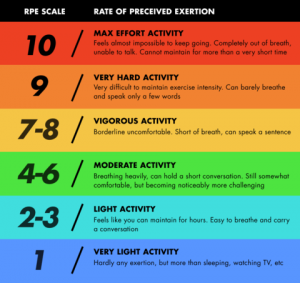Intensity vs. Duration.
Have you ever wondered which is more important when you’re exercising on your NuStep cross trainer, intensity or duration? Is one better than the other for achieving your fitness goals?
The short answer? They’re both important.
That’s why, when the U.S. Dept. of Health and Human Services (HHS) released Physical Activity Guidelines for Americans in 2008, it provided specific recommendations relating to exercise intensity and duration.
Now in its second edition, the guidelines recommend that, “for substantial health benefits, adults should do at least 150 minutes (2 hours and 30 minutes) to 300 minutes (5 hours) a week of moderate-intensity, or 75 minutes (1 hour and 15 minutes) to 150 minutes (2 hours and 30 minutes) a week of vigorous-intensity aerobic physical activity, or an equivalent combination of moderate- and vigorous-intensity aerobic activity.”
Exercise Duration
The guidelines also suggest spreading your exercise sessions over the course of a week, e.g., 30 minutes a day. Keep in mind that if your goal is to exercise 30 minutes a day on your NuStep, but doing it all in one session isn’t possible, you can divide your workouts into shorter increments throughout the day and still achieve the same benefits.
Figuring out how to get 30 minutes of exercise a day is one thing but estimating your exercise intensity may seem less clear cut. What exactly do they mean by intensity? Why is it important? How can you measure it?
Exercise Intensity
Simply put, exercise intensity is how hard you feel like your body is working. It is a gauge to let you know whether you’re not working hard enough or you’re overexerting yourself. That’s why it’s important to exercise at the right intensity for your goals. You’ll get more out of your efforts and more importantly, avoid injury.
According to the Mayo Clinic, there are two ways to measure exercise intensity during aerobic activity:
- How your body feels
- Your heart rate
Monitoring how your body feels while exercising is called the rating of perceived exertion (RPE). It’s a subjective measure, with your body providing clues like increases in your heart rate, breathing, sweating or fatigue to help you gauge how hard you’re working out.
For most of us, it’s difficult to distinguish between the different levels of exertion. The RPE Scale (below) is an excellent way to help you judge the intensity of your workout and adjust it, as necessary.
For example, your goal is to exercise at a moderate intensity level. After 10 minutes, you start to feel uncomfortable and short of breath. According to the RPE scale, you’ve moved into the vigorous activity level. To get back to the moderate level, you can decrease the resistance on the NuStep and/or slow your steps per minute (SPM).

Measuring your heart rate with a heart rate monitor or an activity tracker is another way to gauge your exercise intensity. The goal is to keep your heart rate in the target zone. For detailed information and recommendations about target heart rate, the American Heart Association is an excellent resource.
Finally, if you are new to exercise, the best plan is the one that works for you. It’s better to start slow at the rate you can manage. Set achievable, realistic goals. Then once you feel comfortable, gradually increase your duration and intensity over a period of time and start working toward a new goal.
Always consult your health care provider before beginning any physical activity.

